Enab Balad’s Investigation Team
Ahmed Gamal /Reham al-Assaad/ Mourad Abdul Jalil
At al-Nasr camp in Qah town, north Idlib, the heart of Myriam stopped beating due to the severe cold that raged her family’s worn-out tent, where there were no proper heating appliances. The family mourned the girl who died on 13 January.
According to the doctor of the camp, the seven-month-old girl’s calamity is the result of severe cold and malnutrition, for temperature in the region has decreased below-zero.
“This year I was unable to provide my family with a heating appliance that would protect my nine children against the bitterly cold winter. We were living inside a worn-out tent which lacked living standards” says the father of the child, Yacine al-Hussein.
Myriam was not the only child victim of the cold in IDP camps in northern Syria. Another child died hours after delivery in December 2018 as a result of the cold and poor conditions and services in the Hazanu Camp, northern Idlib.
IDP camps in north Syria have witnessed many disasters due to the rains and floods that have occurred several times during last weeks. Thousands of tents have drowned causing huge property damage, in addition to the human casualties and an unknown number of sick people.
These accidents occurred amid the significant decrease in temperature in the region and the absence of heating appliances in many camps. This situation threatened the lives of patients, children and elderly people and caused the death of two children.
Campaigns held on social media websites and distress calls launched by the local councils in north Syria urged humanitarian organizations to move towards containing a crisis that afflicts camp residents each winter, amid demands for an end to seven years of suffering and questions about the reasons behind the recurrence of such crises.
Tents of northern Syria facing watercourse …
A torpid response to a seasonal crisis
The “Response Coordinators” team in northern Syria documented the deaths of two children due to the bitter cold at al-Nasr and Hazanu camps in Idlib Governorate, and 9,000 tents were damaged because of the storm that hit the region last week, according to statistics released by the team and acquired by Enab Baladi.
Last December, the team issued a statement declaring that more than 6,500 displaced families and about 550 tents were affected, 220 of which were completely washed away in Atma, al-Omar, al-Anfal, al-Sabreen and al-Weiss camps, as well as Saraqib, Maarat al-Nu’maan and other random camps.
Floods caused around 23,000 displaced people to suffer huge losses during the current winter season and destroyed more than 3,000 temporary shelters, said Stephane Dujarric, the Spokesperson for the United Nations Secretary-General, during a press conference held on 9 January. He also stated that “the humanitarian situation in North-west of Syria has become worse because of the severe weather and floods.”
This situation has revealed thousands of tragic stories of displaced people, including those whose tents sank or who suffered from extreme cold and lack of basic services.
The 50-year-old woman, Noura (Umm Alaa), had to collect some plastic waste and sticks with her children from the roads around the camp where she lives in south Idlib, to make use of them as a source of heat instead of the fuel that the camp is lacking.
Umm Ala, a displaced woman from eastern Idlib countryside, has been living in al-Fida IDP camp in south Idlib for two years. She said that she has no source for heat to protect her children during the cold winter and the storms of the north. This has caused her and her children to suffocate and suffer from other diseases because they have no heating appliances.
The situation of Aziza, a 50-year-old displaced woman living in al-Amal camp in the vicinity of Ma’arat Misrin, south of Idlib, is no different than Noura. She told Enab Baladi that she spends her night with her children trying to prevent the tent from being ripped by wind and dig waterways next to the tent to avoid being drowned by heavy rain.
Abu Ahmed, who is living in the western suburb of Aleppo, lost his tent and all his belongings after being affected by the floods that swept through the area and forced him to flee with his children.
During an interview with Enab Baladi Abu Ahmed stated that this accident left him with no heating appliances to protect his children from the bitter cold. This situation pushed him to burn some waste and plastic seeking warmth and calling relevant authorities, which “did not respond.”
Organizations are semi-paralyzed
“In case of disasters and emergencies, the response of the relevant organizations is quick, but during the recent storm the response of all the organizations has been very limited and weak too,” said Mohammad Hallaj, head of the “Response Coordinators” team in northern Syria.
He added that dereliction in the camps in the recent period is the result of several factors, the most important of which are the obstacles brought by the parties in control of those areas. Most of the time, they prevent some organizations from fulfilling their duties there. In addition, last year has witnessed an increase in demand and need because of the number of displaced people from Idlib or other governorates. The increasing number of displaced persons affected the situation negatively and contributed to the state of dereliction in the camps.
The corruption of some of the powerful figures and administrators at the camps, as well as the sponsors, is another factor, which has contributed to the dereliction toward the displaced people; in addition to the absence of relief and services allocated for them for long periods of time, according to the head of “Response Coordinators” team.
Halaj pointed out that changes occurring at the level of the map of control in the north are contributing to the reduction of support allocated for camps, which could be cut down completely. This is what happened when medical support stopped after the recent domination of Hay’at Tahrir al-Sham in the north of Syria.
Fouad Said Issa, a member of the Board of Trustees of the Violet Organization, told Enab Baladi that the relief organizations have provided immediate response to the disaster-stricken camps, such as rescuing displaced people, evacuating the flood-stricken camps and transporting the refugees to other places, in addition to delivering care and relief services.
After that, the relief organizations began to repair the damage and provide new tents instead of the damaged ones as well as some materials available to the refugees in order to ease their losses. The priority of the relief response is to rehabilitate the sewage networks, repair the roads and provide some relief support according to the capabilities of the organizations concerned.
The organizations operating in the north attribute the lack of public and relief services in many camps to the decline in funding offered to the region, due to several considerations related to the difficulty of conducting relief activities, the challenges facing humanitarian teams to reach these camps; in addition to other reasons related to changes of political domination in the area.
These factors have contributed to the reduction of international support for the organizations supervising these camps, as well as political and military determinants in the region in general, adding to that some corruption and dysfunctionality cases regarding the management of camps or organizations, according to Issa.
Syria Civil Defense intensifies its emergency services
Syria Civil Defense team, known as the White Helmets, provides emergency services to the disaster-stricken camps within its available resources, such as rescuing displaced people, opening roads, pulling out flooded tents, as well as providing emergency relief in case of disasters as part of the organization’s basic duties.
During all circumstances, emergency services are considered by Syria Civil Defense as a basis of the organization’s work. The White Helmets crews and tools are invoked in all cases of bombing, explosions and natural disasters, such as floods and deluges; similar to the ones that took place successively in the north of Syria during the past weeks.
According to the Director of the Civil Defense Directorate in Idlib Governorate, Mustafa al-Haj Yousef, the activities carried out by Syria Civil Defense consist of rescuing and fire extinguishing operations, helping the wounded in cases of war and harsh weather, etc.; in addition to repair and rehabilitation works and all public services, as well as saving displaced people and camps when disasters strike, namely, rainstorms and floods.
Al-Haj Youssef told Enab Baladi that “Syria Civil Defense team could not control the recent disaster which was greater than the organization’s capacity. This natural disaster was exceptional. However, we did our best while providing what we have been able to do. We have been working to open roads, drain floods’ water and save displaced people as well as submerged tents.”
The absence of a department responsible for organizing this type of work in the north of Syria obliged Syria Civil Defense to fill this void through carrying out its organized activities in various fields and according to available resources, as al-Haj Yousef puts it.
Solutions to save camps from drowning
The reasons that led to drowning the camps with floods’ water, especially the random ones in the north of Syria, are numerous. The main reason for such phenomenon is building camps in valleys, lowlands or in mountain slopes which are usually exposed to floods in the winter, according to the head of the Response Coordinators team in the north of Syria, Engineer Mohammad Hallaj.
The absence or closure of sewerage networks during the occurrence of heavy rains causes tents to sink, just like what happened in Atme camp, north of Idlib, last month. On the other hand, the camp’s proximity to flooding rivers results in submerging tents, as in the case of Deir Balut camps, north of Aleppo.
However, Hallaj pointed out to simple solutions that reduce or sometimes prevent the devastating effects of floods during the winter from happening. He described these solutions as “emergency or temporary” quick fixes that consist of lifting tents from the ground level or moving it from valleys and lowlands to high and suitable areas.
The other solution is the construction of a rainwater drainage network, such as digging a trench around the camps to absorb large amounts of precipitation, as well as digging a trench around the tent. As such, the purpose of these trenches is to absorb the largest proportion of rainwater as a partial solution to alleviate the damages of floods, according to Hallaj.
Clay and cement houses: Alternatives the United Nations rejects
Many Syrian refugees, based in neighboring countries like Turkey and Jordan, live in manufactured caravans such as in the Kilis 1, Kilis 2 and Ottoman camps.
In the Zaatari camp, in Jordan, there are 26,000 fully equipped caravans, which are home to nearly 80,000 refugees. A solar power plant worth 15 million Euros and funded by the German Development Bank was built in order to provide the camps with electricity for 14 hours a day, Ammon News reported early this month.
The area of the caravan is between 22 and 30 meters; and each one costs between $3.000 and $5.000 (the price varies according to the increase of materials prices). A caravan is mobile and can accommodate a family of eight persons. It cannot be damaged by harsh weather. However, the provision of these caravans needs international support and powerful organizations, according to Engineer Mohamed Mazhar Sharbaji.
Eng. Sharbaji, who previously served as head of the engineering division in the countryside of Damascus, told Enab Baladi that a project was supposed to be implemented in cooperation with the Local Council in the town of Ihtamilat in the countryside of Aleppo. It aimed at building a residential community to accommodate 3,900 people (860 families) and provide infrastructure and solar energy at a cost of $12 million. But, the project encountered obstacles, most notably the lack of funding.
The second idea is clay houses, which can be implemented at a lower cost. The project was executed in the north of Syria by some humanitarian and service organizations operating in Idlib, in particular the Qatar Red Crescent, which built five villages, including al-Fardan, Harem and Ibn Sarai, and equipped them with all necessary services, in addition to establishing a health care unit, a mosque and an oven.
There are three models of these clay houses, including 24 square meters units, 36 square meters units and 60 square meters units. Each house can accommodate eight persons, and it costs less than cement houses. As such, a square meter of the clay house costs $50, i.e. a house of 40 meters at a cost of $2000; while a square meter of cement house costs between $70 and $100 depending on the type of the housing unit.
Clay houses need annual maintenance due to erosion because of weather factors. They are also characterized by thermal insulation and wall thickness of up to 20 centimeters, according to an engineer in the Aleppo countryside, who asked to remain anonymous.
The engineer told Enab Baladi that the temperature was measured inside and outside the cottage and the difference was between nine to 12 degrees, while the difference of temperature outside and inside the tent was one degree only, and in the cement house there is a difference of three degrees, while in the “caravan” there is a difference of four degrees between inside and outside.
These experiences raised many questions about the non-implementation of these clay houses in the refugee camps in the north, but the member of the Board of Trustees of the Violet Organization, Fouad Said Issa confirmed that many proposals and offers were presented to organizations to provide mobile industrialized rooms “Caravans” or cement rooms, but the international organizations, the United Nations and other refugee organizations did not approve of these projects.
Said Issa clarified that the United Nations refuses totally to fund housing projects that move displaced people from tents to industrialized rooms because it is considered a resettlement process that prevents their return to their towns and villages.
Lebanon’s random camps
Prone to disasters and weather variations
Random camps were built downriver and at the heart of the snowstorm that struck the region recently, causing the same uproar that it is causing each year, with great human and material damage, and a continuing tragedy that tops headlines and officials’ statements as if it is the first of its kind.
Talks about the randomness of these camps, which have not been able to gain official status despite the crises that affected them over seven years, raised several questions, most notably: who is responsible for managing these camps? Why do not refugees change their place of residence in crisis areas? How could the crisis have been avoided? How did governments react to the recent crisis?
The organization of random camps: Is it the government’s or relief organizations’ responsibility?
Local and international relief reports of the damage caused by the blizzard to Syrian refugees in Lebanon indicate that its effects were severe on those living in “unofficial” random camps, particularly in the Lebanese Arsal area which includes more than 100 random camps, while it had less impact on refugees in official camps, which are often the focus of international donors and international relief agencies.
The randomness of these camps led to the loss of the local authorities responsible for their management and organization, and perhaps to the accusations of who is responsible for them, which led to the tragic reality that faces the refugees every winter and with the first storm that hits their camps.
The Lebanese rights activist Nasser Yassin, Director of Issam Fares Institute for Public Policy and International Affairs of the American University of Beirut, pointed out that the camps hit by the storm in the Lebanese region of Arsal are usually run by relief organizations, but in coordination with the municipalities of each region.
Yassin said in an interview with Enab Baladi that “the Lebanese municipalities respond to refugee crises differently, according to the activity of each municipality and according to its capacity, financial allocations and programs for the relief of Syrian refugees,” pointing out that the central government does not impose a unified policy on all municipalities, but leave them free to deal with the subject.
What aggravated the situation is the government paralysis in Lebanon, with the absence of the government formation for more than eight months, in addition to the inability of the Lebanese economy to respond to the crises of the Syrians in the random camps, whose number is around 200,000, according to Yassin.
However, the Lebanese human rights activist pointed out that some government agencies responded “shyly” and according to their capabilities to the last storm. The Lebanese army has evacuated some affected Syrian families to schools and camps away from the storm. The Lebanese Ministry of Interior has also announced the mobilization of its affiliated bodies.
Survey: Governments bear responsibility
An opinion poll conducted by Enab Baladi newspaper showed that Syrians held the governments responsible for the deterioration of the situation in Syrians’ camps spread in the Syrian territories and neighboring countries.
In a question via Enab Baladi site, around 75 participants responded to the question of who is responsible for the deteriorating situation of displaced persons in the camps. 73 percent of the participants held governments accountable, while 18 percent of the participants held camp administrations responsible, and 10 percent of the participants held civil society organizations responsible.
In the user comments section on Enab Baladi Facebook page, Samar al-Bardan said that responsibility is shared; each party is responsible from its position. Camps administration has experience from previous years, noting that it must be prepared and should predict crises before they occur.
Al-Bardan said that “governments are in charge of international support to sustain the camps. They are also responsible for its distribution and increasing its volume in winter and starting to act before storms, while civil society organizations are responsible for constant alerting and reminders.
Ibrahim Mansour held the “revolution,” which “displaced them from their homes and caused them to live in tents responsible,” as he put it, while the user Abu Ghiath Abdul Aziz said that the opposition institutions are the parties responsible.
“Voluntary” efforts and late donations
As for the response of the local relief organizations, the Syrian relief activist in Lebanon, Mohamed Hassan, believes that the failure of the Lebanese government to sign the Geneva Convention on the protection of refugees has impeded the functions of the United Nations and its relief agencies, whose programs usually focus on the recognized official camps.
Nevertheless, international norms oblige the Lebanese government to provide aids, protection and decent living for refugees fleeing to its territory and facing life-threatening dangers.
According to Hassan, the response to the recent storm was an individual and not an organizational effort, referring to “humanitarian” intervention by Lebanese and Syrian volunteering teams, in addition to the intervention of some Lebanese municipalities, as well as donations from foreign countries.
Hassan said in an interview with Enab Baladi that the United Nations “failed” to compel and pressure the Lebanese government to protect Syrians fleeing the war and provide them with “decent” shelter, or at least rehabilitate their camps that become covered with snow every year, making them stuck between a government that “does not welcome them” and organizations that do not have the freedom of action.
The Syrian activist talked about the spread of corruption among the local relief organizations in Lebanon, especially concerning the distribution of simple building materials for the protection of tents, saying: “There are complicated cases of corruption that are difficult to be monitored and documented and to hold those responsible for them accountable.”
In contrast, the Lebanese human rights activist Nasser Yassin considered that the available relief system in Lebanon could not cope with the crisis because of the large numbers of Syrian refugees in the random camps, estimated at 200,000 people, amid the absence of organized relief programs and the fluctuation of support provided to them.
What is the role of refugees in such crises?
Referring back to the UN conditions for the establishment of any camp, we find out that most of these conditions, and perhaps all of them, are not met in the Syrian camps on the Lebanese-Syrian borders, which were built by the Syrians themselves despite the objection of the Lebanese government that considered the presence of such camps a reality imposed on a country where refugees make up a quarter of its population.
In this case, many questions have been raised about the reason that prevents the refugees themselves to relocate their tents although they are well aware that they are threatened to drown in rain, floods and snow, and to be affected by any storm that would blow in their areas.
Lebanese human rights activist Nasser Yassin considers that the Syrian refugees in the camps are the “weakest circle” in all the crises that are occurring around them. He pointed out that they are in a state of economic and social deficit. They have not been accepted by the hosting communities, and they are mostly part of a social class living below the poverty line.
Yassin explained to Enab Baladi that the refugees do not have freedom of movement on Lebanese territories and the choice of where to build their camps. The Lebanese government claims to restrict their movement for “security reasons.”
He added: “Here lies the role of civil society organizations, aid agencies and municipalities, which must use modern technologies and science to find the right environment to set up the camps, even if they are random.”
Yassin continued: “Foreign donors are talking at international conferences and forums that they are devoting modern technologies to serve refugees in the camps. Why have not these technologies been used to serve refugees facing cold and heat crises?”
Mohammed Hassan, a refugee relief activist, interested in refugee matters in Lebanon, refused to hold the Syrian refugees responsible for building their camps on uninhabitable lands and that do not have water discharge. He pointed out that the Lebanese government has been, and is still, preventing them from moving to habitable camps, fearing that this would contribute to their resettlement on their territories for other years.
How could the crisis have been avoided?
At a time when popular, media and relief calls are mounting to take the necessary measures to avoid expected crises in refugee camps, many believe that under the aforementioned circumstances, these crises cannot be overcome without a radical change that would lead to the end of the refuge life itself.
Commenting on this matter, the Lebanese human rights activist, Nasser Yassin, considered that dealing with the refugee crisis anywhere in the world is carried out following three options: first, by hosting refugees in cities and towns and by the government’s response to their crises; second, by resettling them in another country that can host them; and third, by their repatriation after the availability of security in their homelands.
In this case, we find that these options have not been followed in dealing with the Syrian refugees’ issue. The Lebanese government is unable to host them because of the internal situation and weak economy. Moreover, the UN resettlement programs are very slow and take place at different intervals. In addition, the security and living conditions in Syria are not yet suitable, according to several human rights reports.
Nasser Yassin added: “In this case, a large number of Syrian refugees are left in exceptional but unfortunately long life conditions.” He considered that it is difficult to fully avoid the winter crises in the refugee camps, but they can rather be mitigated by good preparation of a full relief system long before the disaster, which was not done during the recent storm.
UN standards for camp establishment around the world
The United Nations norms and laws reject the idea of the establishment of random camps for those fleeing conflicts and disasters anywhere in the world, with the stipulation of a set of standards regulating the establishment of any camp and guaranteeing refugees a “decent life” as a minimum level.
In this context, the UNHCR Charter set up standards for camp establishment following sound and healthy bases, as part of the emergency response until the end of crises and the return of refugees to their homelands. Among these standards, as stated in the UNHCR Charter, are:
- Consultation with the relevant authorities in charge of water supply and sanitation networks as well as environmental engineers to determine the appropriateness of establishing a human gathering on a given land.
- Establishment of the camp on a semi-sandy soil that absorbs rainfall and retains solid waste in latrines.
- The governments of the hosting countries are responsible for the camp administration. In the absence of sufficient resources, they can ask the help of the United Nations organizations and their affiliated relief agencies.
- The camp should not be built in a region close to conflict zones, from which the refugees fled, to ensure their security.
- Provision of adequate space for individuals inside the camp, at an average of 45 square meters per person, and the allocation of places for educational and service facilities.
if you think the article contain wrong information or you have additional details Send Correction
النسخة العربية من المقال
-
Follow us :
Most viewed
- Negotiations between SDF and Damascus: Agreement on generalities, disagreement on details
- Suspension of EU sanctions: Limited impact fails to meet recovery needs in Syria
- Challenges paralyzing electricity sector in Syria
- Peace under pressure or division... What are Israel's plans and tools in Syria
- Israel threatens Damascus via Jaramana












 Children walking through mud amid the storm that hit northern Syrian camps - 2018 (AFP)
Children walking through mud amid the storm that hit northern Syrian camps - 2018 (AFP)





 A
A
A
A
A
A
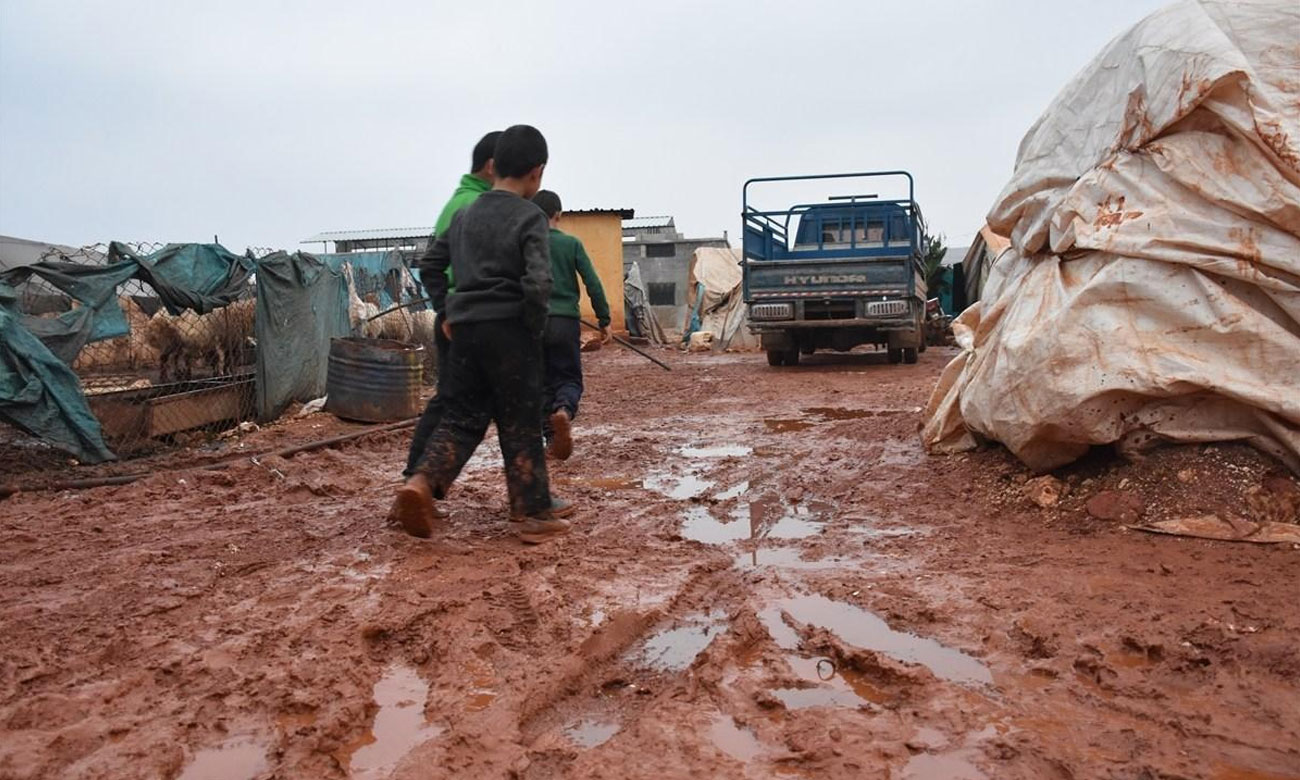
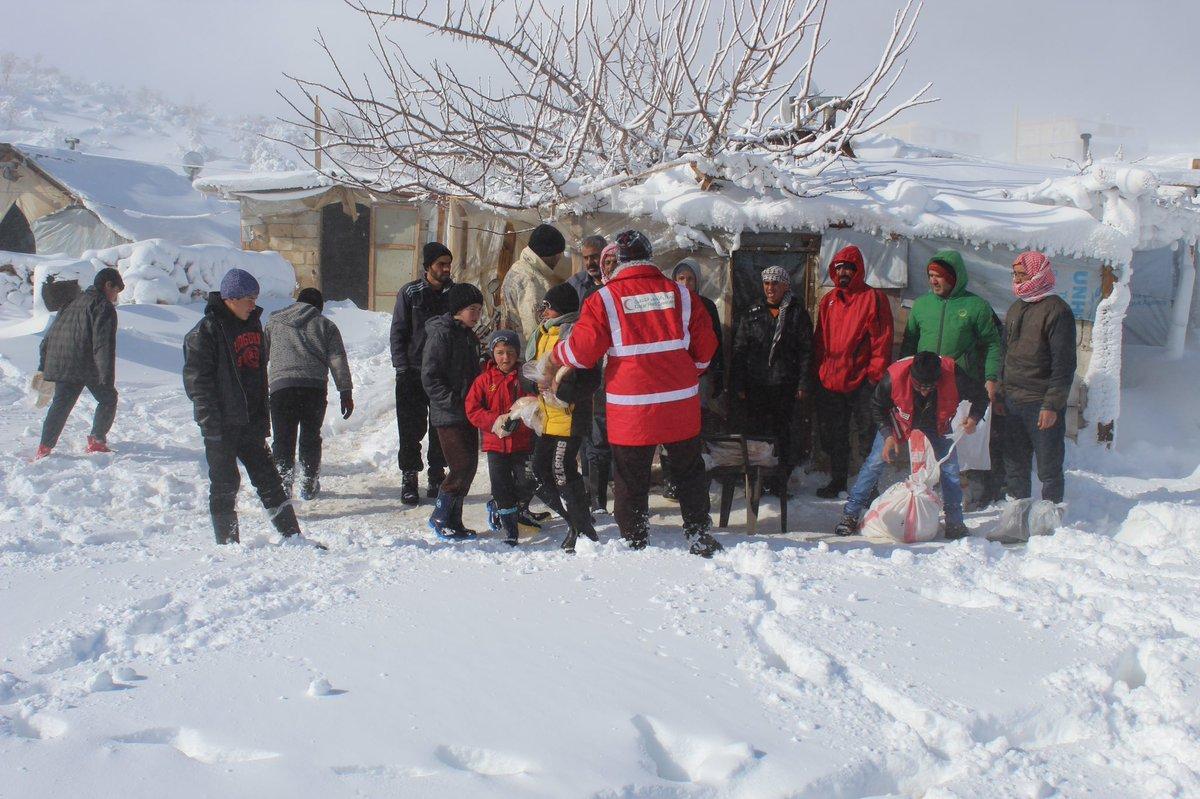
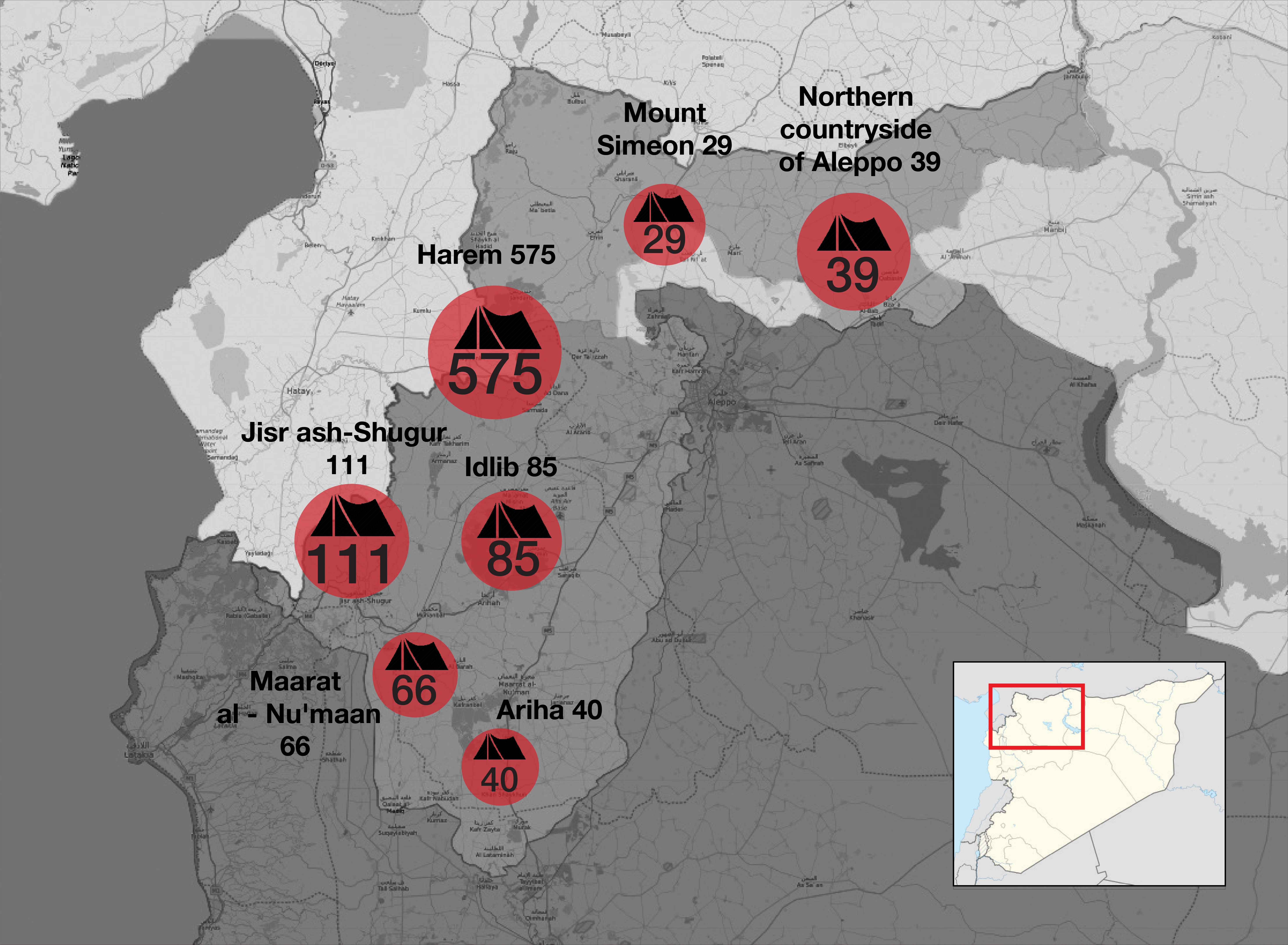
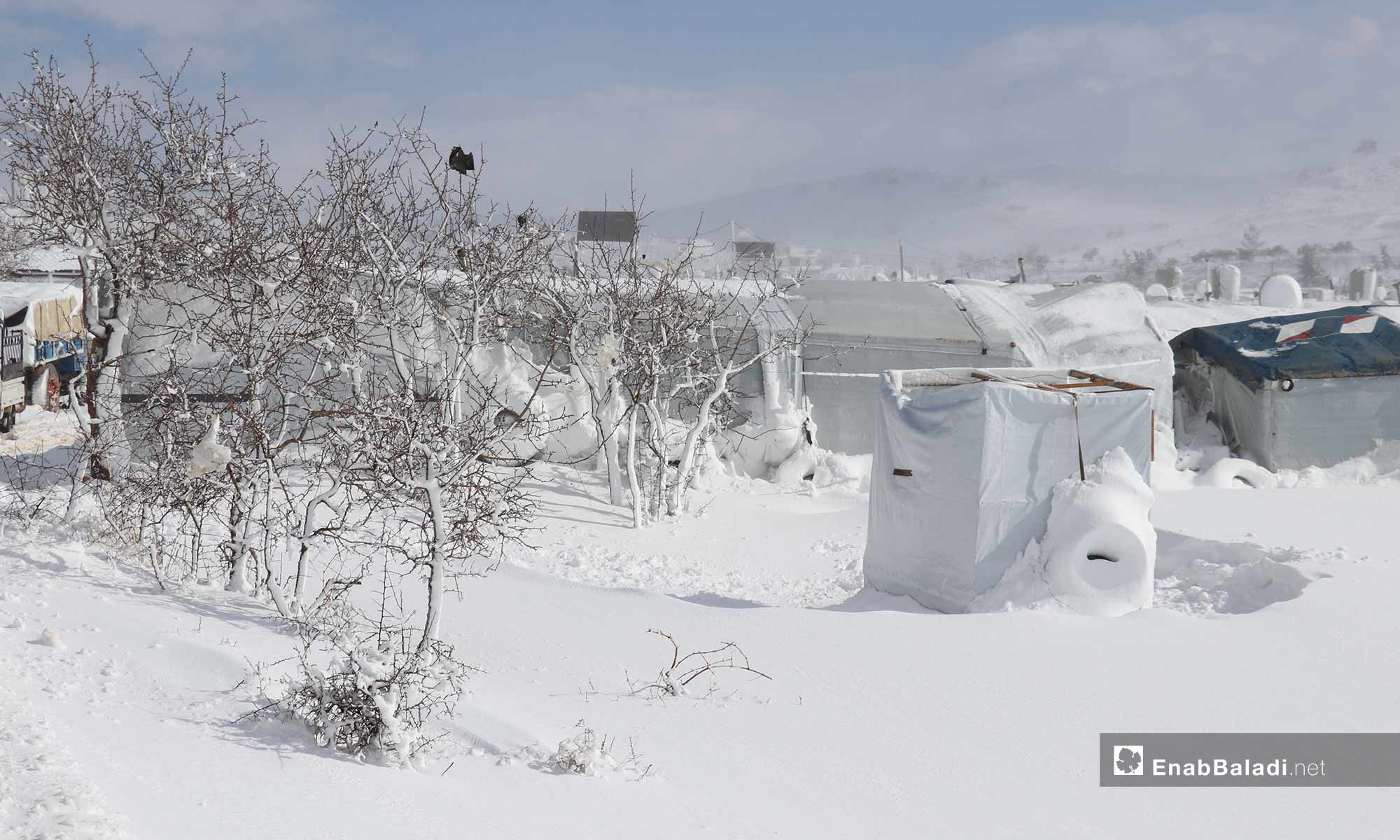
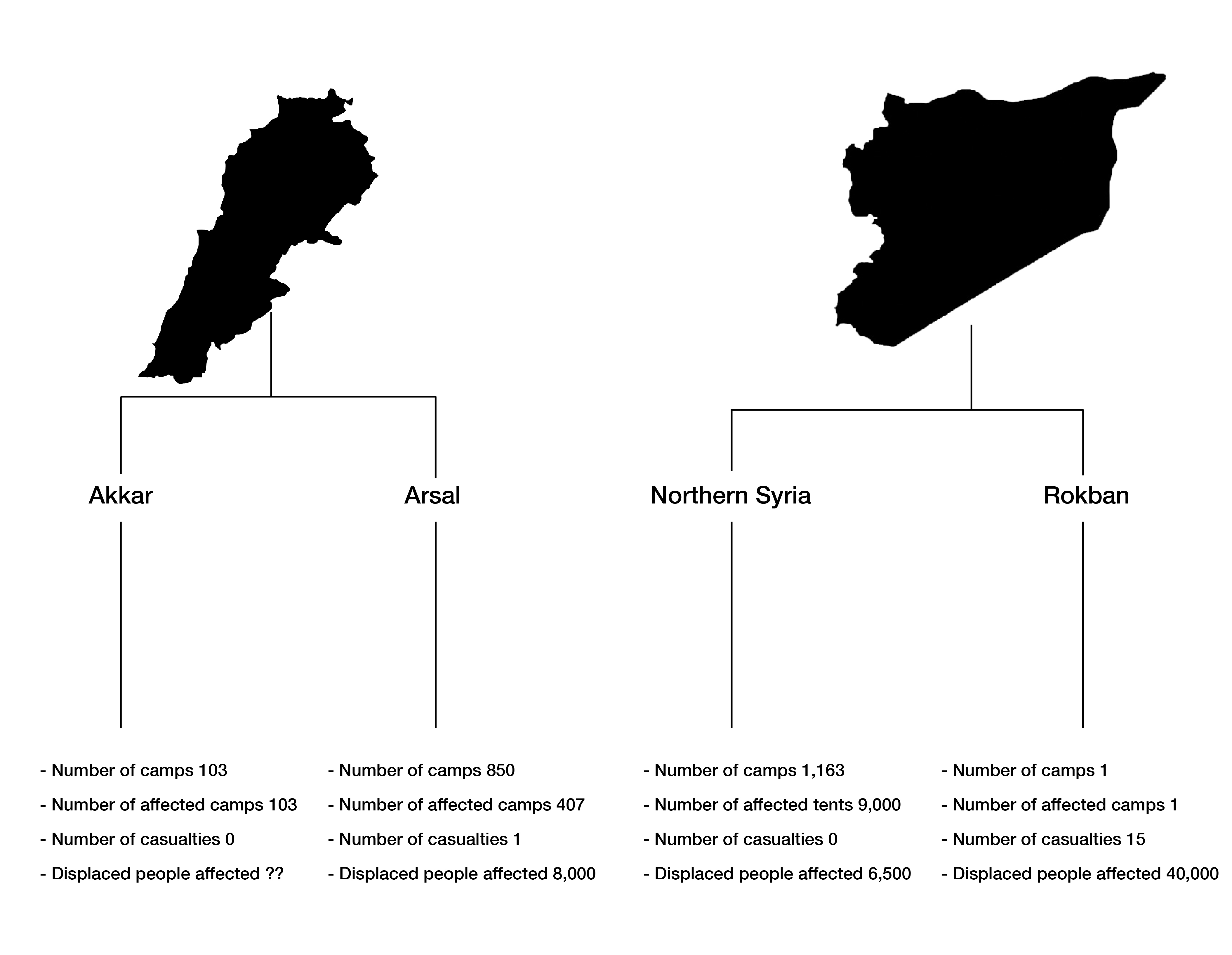


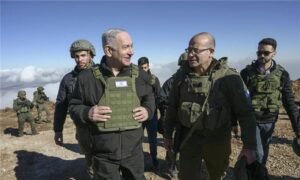
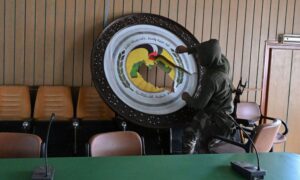
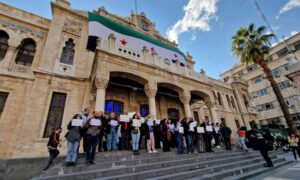
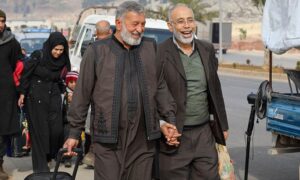

 More In-Depth
More In-Depth